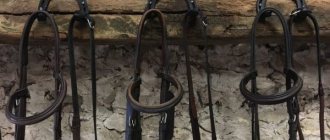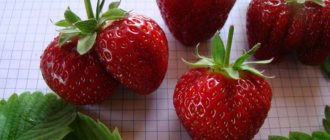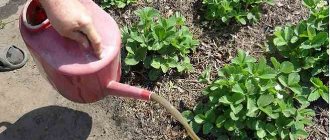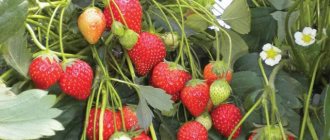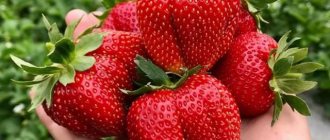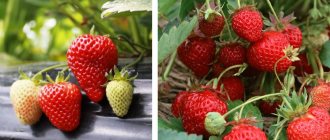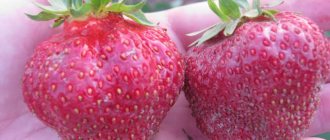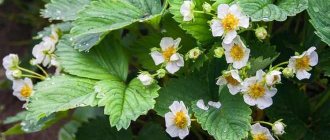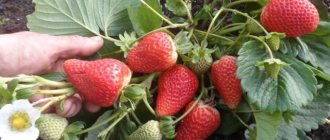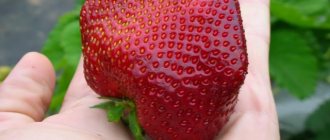The origin of the Chamora Turusi variety is not precisely established. According to information from various sources, traces lead either to the Queen Elizabeth variety or are lost on the Japanese Islands. Where did Chamora Turusi (Kurushi) come from? Did the painstaking work of agronomists or the result of experiments in folk selection become the basis of a new variety? Now this is not of fundamental importance - large-fruited garden strawberries with unique properties have confidently settled in garden plots, without even being included in the State Register.
Description of the variety
Chamora Turusi strawberries are classified as mid-late varieties. Depending on the region of growth, the first berries ripen in mid-July (Middle zone) or in late July - early August (North-West and other regions with a cooler climate).
- In large-fruited garden strawberries, not only the berries are impressive in size: a powerful bush up to 30-40 cm tall with light green leaves requires an interval between plants of at least 50 cm when planting and growing in a row. The powerful root system copes with feeding even a densely leafed spreading bush in difficult growing conditions.
- The variety is characterized by increased formation of mustaches and daughter rosettes. Layers quickly take root and can bear fruit already in the 1st season.
- The peduncles of the Chamora Turusi strawberry match the bush - tall and strong, at the base they have a diameter of 0.6-0.8 cm. In the 1st year of growth, 1 peduncle is formed on the bush, from the 2nd-3rd year - up to 10-15 things.
- The largest berries ripen in 1 year of fruiting - up to 100...150 g, subsequently the berries become somewhat smaller (30...80 g), but there are much more of them - up to 1.3...1.5 kg. from the bush.
- Ripe fruits are dark red with a crimson or terracotta tint; the top of the berry often remains light green and does not ripen. The shape of the berries of the Chamora Turusi strawberry is the most diverse - within one area there are round, conical, comb-shaped fruits with irregularities and folds.
- The plant is sensitive to lack and excess of moisture.
- The variety is characterized by high winter hardiness - up to -20...25 degrees. There is evidence that bushes successfully winter under snow even at -35 degrees.
- The tendency to fungal diseases and rot is average.
- In one place without replanting, bushes can grow for up to 10-12 years.
How to care for “Chamora Turusi” strawberries after harvest: preparing the plant for winter
Having collected a lot of tasty berries, you can prepare the plantings for the cold weather. At the end of August - beginning of September, adult bushes are pruned: leaves and tendrils are cut off (closer to the base). The stems are not touched. For seedlings under 2 years of age, this procedure is traumatic and is abandoned.
Important! Diseased leaves and shoots are removed without waiting for August. It is better to put them in a compost pit and sprinkle them so that carriers of the disease do not come out.
Then the soil is loosened, cleared of weeds and treated with a weak fungicidal solution. Closer to frost, they feed with fermented manure with a small addition of ash. Nitrophoska in combination with ash and potassium sulfate also strengthens the bush (in the proportion of 2 spoons, a glass and 30 g, respectively).
The final step is to lay down a thick layer of mulch or manure. 5-7 cm will be enough. Pine needles, peat chips and finely chopped straw are suitable. The foliage can become compressed and “clog” the roots.
Materials like agrofibre will also preserve strawberries. But they must be pulled onto the arms. In this case, you will have to visit the dacha at least once a month in winter - the coating may sag and needs to be corrected.
a brief description of
Advantages of the variety
- Fruiting is extended, up to 2 months. with regular watering;
- bushes bear fruit already in the year of planting;
- high yield 2.5…3.0 kg/m2;
- very tasty and aromatic large berries (up to 100...150 g) of a beautiful presentation;
- dense berries tolerate transportation and storage well;
- universal use of fruits, including deep freezing;
- in the conditions of the Central region, the bed overwinters well without shelter.
Disadvantages of the variety
- increased mustache formation requires regular monitoring and thinning;
- hard to tolerate heat (baking) and lack of moisture;
- No less dangerous for plants is excessive soil moisture, which provokes the appearance of rot (especially gray rot) and fungal diseases;
- To get a full harvest, before flowering and after harvesting the berries, it is necessary to carry out preventive spraying against fungi and rot.
The most valuable thing about the berries of the Chamora Turusi variety is their ability not to lose shape, to remain dense even after freezing and after boiling in syrup. Independent tasters rated the taste quality as 4.5 points out of 5 - a harmonious sweet and sour taste is combined with a real strawberry aroma.
The following drugs will help against late blight of the root system and root fungus: Mancozeb and Fundazol.
Pest protection
In addition to fungal diseases, the plant is plagued by harmful insects. Among them are the larvae of the cockchafer. When affected, the leaf blades turn intensely yellow and fall off at the beginning of summer. When attacked by a strawberry mite, the leaf blade becomes deformed and twists.
If pests appear, immediately take the necessary measures to preserve the plant. It is recommended to treat with Karbofos, Fitoverm, Neoron. To prevent the appearance of the May beetle, treat the soil before planting with Bazudin, Aktara, and Antikhrushch.
Anyone can grow a crop with large berries; you just need to show a little effort, patience and give the plant the necessary care.
Landing
The strawberry bed is set up in a well-lit place. Preference is given to fertile, loose soils without stagnant water. The strawberry variety Chamora Turusi can be planted in 2 terms: in the fall - in August or in early spring - in April.
- The bed for planting strawberries is prepared in advance - 2-3 weeks in advance for autumn planting or in the fall for spring planting.
- The area is cleared of weeds and dug up, carefully selecting the roots of perennial plants. Apply 7-8 kg per 1 m2 of beds. humus or compost. The mineral composition of the soil is enriched with wood ash in an amount of 0.5 liters. per 1 m2
- The seedlings are planted in rows with an interval of 60 cm between plants, the row spacing is 80 cm.
- Layers are planted without deepening the central rosette. Plants are well watered and mulched.
Planting strawberries with mulching beds improves the survival rate of the cuttings. Plants can survive with almost no watering. The bed does not require weeding or loosening.
Attention! An important advantage of growing on mulch is that during the fruiting period, heavy berries do not come into contact with the ground, do not rot or get dirty.
Straw, sawdust, dry leaves, weeded weeds, wood chips, etc. are used as a mulch layer. Organic mulch in the garden bed can be replaced with a cover made of spunbond or similar non-woven material.
Growing and care
When growing Chamora Turusi strawberries on mulch, the gardener gets rid of tedious weeding, loosening and daily watering. The activities required for a strawberry bed will not take much time and will bring great benefits.
| Early spring | Treating the bed with a fungicide to prevent fungi and rot. You can use Bordeaux mixture for garden trees. Fertilizing with organic matter and minerals at the rate of 1 bucket of humus + 1/2 liter. ash per 1 m2 |
| From the moment the buds appear until the end of fruiting | Water 2-3 times a week or install drip irrigation. Removing whiskers from a fruit-bearing area |
| After harvest | Fungicide treatment. Fertilizing with water-soluble mineral fertilizers of the Master type for berry crops. Repairing the site and planting new beds |
Attention! Gardeners cannot agree on the need to mow last year's leaves in the strawberry patch. Many years of experience in growing berries in the Central region and to the north have shown that old foliage contributes to snow retention and better wintering of strawberries. Such plants begin to grow earlier, bloom and bear fruit earlier.
In a cool climate, to guarantee the wintering of strawberries, even of such a hardy variety as Chamora Turusi, it is advisable to take care of snow retention. In regions with traditionally little snow, it is advisable to additionally cover the bed with spruce branches or fallen leaves - this will be quite enough to prevent frost from damaging the buds of flower buds.
Reproduction
The owners of strawberries of the Chamora Turusi variety are extremely lucky - only 10 bushes are able to provide layering with an area of 1 sq.m.: with high-quality care, each mother bush produces at least 5-7, and more often - 8-10 rosettes, which quickly take root and are capable of growth in just 1 year give a few berries.
- For faster and more productive reproduction, mother plants should be regularly watered and flower stalks removed.
- The resulting air layers on the tendrils must be evenly distributed between the rows, carefully pinned to the soil or pressed with a weight.
- With regular watering, the mustache quickly takes root.
If autumn planting is not part of your plans, there is no need to separate the cuttings from the mother bush. After spring planting, they will grow into strong plants, which in 1 year of growth will give you large berries the size of a small apple - weighing at least 80-100 g.
Competent feeding
You can get excellent results from this tasty and large berry only by applying timely fertilizers. The gardener will need to combine organic and mineral compounds, in no case exceeding the permissible norms for applying such fertilizers.
Experienced gardeners recommend making several fertilizer applications:
- in spring before flowering begins;
- immediately after the formation of ovaries;
- in the summer after the start of fruiting;
- in the fall in preparation for winter.
The first application of fertilizers is carried out simultaneously with pruning the bushes. At this time, plants will require a large amount of nitrogen, which is necessary for the growth of green mass. As a fertilizer, you can use a solution of chicken manure, 20 grams of which are diluted in 10 liters of water.
Immediately after flowering and during the period of active fruiting, complex mineral compositions are used, which include phosphorus, calcium and potassium. This will improve fruit formation, guaranteeing the excellent taste of the ripened harvest.
After the end of the active fruiting period, the bushes are fed with nitrophoska, and in the fall, when preparing the plants for winter, a small amount of mullein is added. The microelements contained in this fertilizer strengthen the strawberries, which subsequently easily withstand winter cold.
Reviews
I have the most flattering reviews about Chamora Turusi. The berries are very large, the yield is high, and the fruiting period is long. The disadvantages include the variety's demands on watering and soil nutrition, but you should not get too carried away with nitrogen fertilizers - it may be affected by gray rot. During hot periods, the berries may bake, so shading is required. For these purposes, I plant dill between the rows. Because of gray rot, I planted two more varieties similar to Chamora: Maxim and Kiss Nelis, but I will write a review about them in the corresponding topic.
Chamora Turusi requires sparse planting, because The bushes are very large, a pattern of at least 60x60 cm is needed. I plant them under drip irrigation and put tape on both sides. The berries are very tasty and have a pronounced strawberry aroma. In hot weather I shade it with agrofibre, stretched at a height of 1.5 m.
My Chamoru is very fond of slugs, especially if the plantings are mulched with straw. I started using spruce opal and mowed lawn grass, it is small and I don’t see slugs under it. I scatter a small amount of the Groza preparation along the border of the beds.
Chamora Turusi is a productive and large-fruited variety with enormous potential. If you overcome the common gray rot and think through measures to shade the crop in the heat, the variety will delight the gardener with delicious, aromatic berries of gigantic size.
